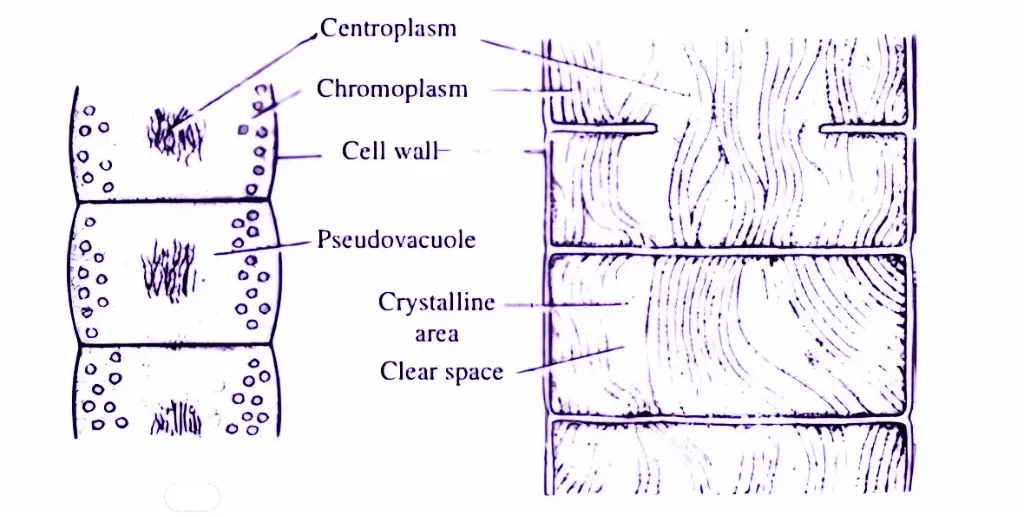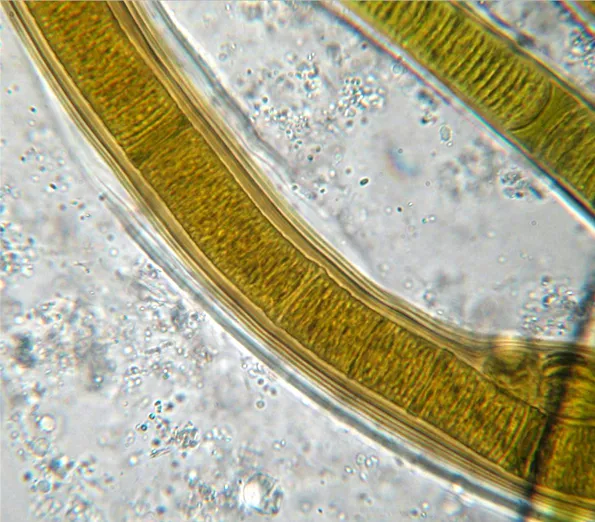Lyngbya exhibits a structural resemblance to Oscillatoria, albeit with a notable distinction: the trichomes in Lyngbya possess a firm and conspicuous hyaline sheath. In contrast, individual sheaths of the trichomes are absent in Oscillatoria.
Lyngbya species can be found in freshwater, marine water, and soil. Each trichome consists of numerous cells arranged in a septate manner, forming an unbranched structure.

In 1959, Desikachary categorized Lyngbya into four distinct sections: Spirocoleus, Heteroleibleinia, Leibleinia, and Eulyngbya. Desikachary described 65 Lyngbya species in these sections, designating L. confervoides as the type species. However, in 1973, Drouet maintained Lyngbya as a part of Oscillatoria.
Taxonomic Position
| Classification | Bacteria |
|---|---|
| Domain | Bacteria |
| Phylum | Cyanobacteria |
| Class | Cyanophyceae |
| Order | Oscillatoriales |
| Family | Oscillatoriaceae |
| Genus | Lyngbya |
Structure
Lyngbya exhibits a structural resemblance to Oscillatoria, albeit with a notable distinction: the trichomes in Lyngbya possess a firm and conspicuous hyaline sheath. In contrast, individual sheaths of the trichomes are absent in Lyngbya.
The cells are wider than tall and exhibit a characteristic Cyanophycean structure. Reproduction in Lyngbya occurs through hormogones. In 1959, Desikachary classified Lyngbya into four sections: Spirocoleus, Heteroleibleinia, Leibleinia, and Eulyngbya.
Cell Structure
When observed under a light microscope, the cell structure of Lyngbya aligns with the general characteristics of Myxophycean cells. The cell wall encompasses a dense mass of granular protoplasm. Notably, Lyngbya lacks a distinct nucleus enclosed by a nuclear membrane.

Within the protoplasm, there is a differentiation between the outer colored region, known as chromoplasm, containing pigments, and the colorless inner region, called centroplasm, which represents the early stages of nucleus formation.
When examined under an electron microscope, Lyngbya shows specific structural characteristics. Typically, there is no mucilaginous sheath surrounding the cell wall. The cell wall itself measures approximately 2000 Å in thickness.
Adjacent to the cell wall, we find the plasma membrane. Halfen (1973) identified two additional layers in the outer region of the cell wall. One layer is approximately 160 Å thick, while the other measures 90 Å in thickness. Numerous pores are present within the structural layer.

Notably, Lyngbya lacks plastids, mitochondria, endoplasmic reticulum, and dictyosomes. The pigments are primarily located in well-developed thylakoids or lamellae. While predominantly concentrated in the chromoplasm region, they may also distribute throughout the cell.
Additional features include the presence of cyanophycean starch, cyanophycin granules, and pseudo vacuoles. Furthermore, the region of centroplasm contains numerous chromatin granules and crystalline bodies.
Movement
While motile cells are not present in Myxophyceae, the individual filaments of Lyngbya exhibit a distinctive pendulum-like oscillating or swinging movement, readily observable in live samples. The filaments of Lyngbya show the following types of movements:
- Oscillatory Movement: The filaments’ terminal part oscillates like a wall clock’s pendulum. This movement is appropriately termed “oscillatory movement.” The genus Lyngbya derives its name from this characteristic oscillatory motion.
- Gliding Movement: This movement occurs along the filaments’ long axis and is often called “creeping movement.” The trichomes move forward and backward during gliding, creating a smooth gliding effect.
- Bending Movement: The filaments display bending movement facilitated by the rapid bending of the extreme tip after each oscillation. This bending motion adds to the filament’s overall dynamic behavior.

Reproduction
Lyngbya only reproduces through vegetative means, specifically by utilizing two known methods: the formation of hormogones and fragmentation.
Hormogones
Hormogones are short segments of trichomes composed of multiple undifferentiated vegetative cells. In Lyngbya, hormogones typically consist of cells situated between two separation discs.
These separation discs are pad-like structures filled with mucilage and possess a biconcave shape, resulting from the death of one or more cells within the filament. These mucilage-filled cells are also referred to as necridia.
The presence of mucilaginous separation discs enables the detachment of hormogones. Hormogones, or hormogonia, continue to move for a period and eventually function as new trichomes, perpetuating the reproductive cycle of Lyngbya.
Fragmentation:
The filaments of Lyngbya can undergo division, forming small pieces or fragments. This division can occur due to the biting of certain insects or young animals and through mechanical or other factors.
Significantly, each of these fragments can develop into a new individual, contributing to the reproductive capabilities of Lyngbya.
Applications of Lyngbya
Lyngbya, a genus of cyanobacteria, succeeds in diverse habitats, such as freshwater and marine environments. This filamentous organism can create extensive mats or blooms on the water’s surface.
Lyngbya is a prolific producer of bioactive compounds, encompassing toxins, pigments, and polysaccharides. These compounds hold immense potential for various applications, including:
- Toxins: Some strains of Lyngbya produce toxins that can harm humans and animals. These toxins can cause various symptoms, including dermatitis, nausea, vomiting, diarrhea, and respiratory problems. In severe cases, poisoning from Lyngbya toxins can be fatal.
- Pigments: Lyngbya produces a variety of pigments, including phycoerythrin, phycocyanin, and allophycocyanin. Lyngbya uses these pigments to capture sunlight and convert it into energy. They can also be used to produce natural dyes and pigments.
- Polysaccharides: Lyngbya produces a variety of polysaccharides, including agar, carrageenan, and furcellaran. These polysaccharides are used in various applications, including food, cosmetics, and pharmaceuticals.
Besides its potential applications, Lyngbya can present challenges as a nuisance organism. It has the propensity to create dense mats on the water’s surface, obstructing sunlight penetration and diminishing oxygen levels.
Consequently, this can harm the survival of fish and other aquatic organisms. Additionally, Lyngbya can serve as a source of waterborne illnesses.
Key Points:💡
- Lyngbya exhibits a structural resemblance to Oscillatoria, but the trichomes in Lyngbya have a firm and conspicuous hyaline sheath.
- Lyngbya species can be found in freshwater, marine water, and soil, and its trichomes are unbranched structures composed of numerous cells.
- Lyngbya lacks individual sheaths of the trichomes found in Oscillatoria.
- The cell structure of Lyngbya aligns with the general characteristics of Myxophycean cells, lacking a distinct nucleus enclosed by a nuclear membrane.
- Lyngbya lacks plastids, mitochondria, endoplasmic reticulum, and dictyosomes but has well-developed thylakoids or lamellae for pigment distribution.
- Lyngbya exhibits oscillatory, gliding, and bending movements in its filaments.
- Lyngbya reproduces through hormogones (short segments of trichomes) and fragmentation.
- Environmental applications of Lyngbya include bioremediation, carbon sequestration, and agricultural and food industry applications.
Frequently Asked Questions
The Lyngbya algae, whether wet or dry, contain toxins that can result in skin and eye irritation. Exposure to water or aerosols, such as water spray, can lead to eye and respiratory discomfort.
Lyngbya is a genus of cyanobacteria, unicellular autotrophs that form the basis of the oceanic food chain.
Filamentous cyanobacteria of the genus Lyngbya are essential contributors to coral reef ecosystems, occasionally forming the dominant cover and impacting the health of many other co-occurring organisms.
Some Lyngbya strains can make toxins that can cause skin irritation. In some cases, strains have been found to make cylindrospermopsin, a toxin that causes liver damage, or saxitoxin, a neurotoxin that can cause gastrointestinal and neurological symptoms.
Oscillatoria exhibits a distinctive appearance resembling a stack of coins, characterized by a rounded tip. It is commonly observed in the water column, where it appears as darker filaments, and in the benthos. In contrast, Lyngbya shares a similar coin-like structure but possesses a distinct sheath, unlike Oscillatoria.
